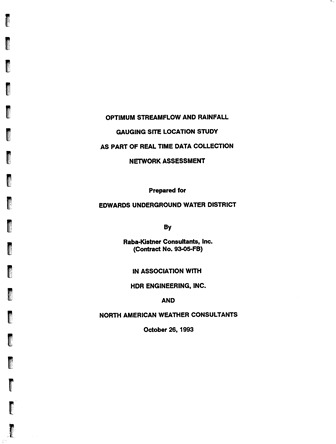Optimum Streamflow and Rainfall Gauging Site Location Study As Part of Real Time Data Collection Network Assessment

| Author | Raba-Kistner Consultants Inc, HDR Engineering Inc and North American Weather Consultants |
| Year | 1993 |
| Description | Streamflow and rainfall optimum gauging study and recommendations for improving accuracy of recharge estimates to the Edwards Aquifer |
| Publisher | Raba-Kistner Consultants Inc, HDR Engineering Inc and North American Weather Consultants |
| Location | Edwards Aquifer-San Antonio Region |
| Summary |
|
Part of the mission of The District is to estimate recharge to the aquifer. To better accomplish its expanded mission, The District has undertaken an evaluation of the existing method of estimating recharge and an assessment of the establishment of a real time streamflow and rainfall collection network. The objective of this evaluation is to enable The District to more accurately estimate recharge to the Edwards aquifer both in terms of the accuracy of the model being used and the availability and accuracy of streamflow and rainfall data input to the model. This, in turn, should enhance recharge estimation as a management tool. The District has contracted with R-KCI to perform this evaluation…. [T]he purpose of The Study is to In order to accomplish this purpose, Exhibit A outlines six tasks which are stated below. Task 1 Identify existing gauges The HDR and U.S. Geological Survey offer different methodologies for computing recharge to the Edwards aquifer. The two methods have been shown to produce different historical recharge figures, especially with respect to the geographical distribution of recharge within the study area. The proposed new streamflow and rainfall gauging network will offer additional data that has not been available before which will change the way both the HDR and U.S. Geological Survey methodologies are currently applied. With new streamflow gauging stations in the Indian Creek, Blanco Creek, Verde Creek, Elm Creek, Leon Creek, Cibolo Creek, and Upper San Marcos River basins, a new recharge calculation method will be required to incorporate data from these gauges in determining the recharge in these basins. Other recommendations for potential modifications to the recharge calculation method include the following: 1) Combining the more beneficial components of both the HDR and U.S. Geological Survey methods Into one single method for computing recharge to the Edwards aquifer. This would allow for a single, unified set of historical recharge estimates to be made as well as allow for more accurate recharge estimates in the future. 2) Current recharge estimates are computed on a monthly time step. Generating recharge estimates on a daily time step using daily streamflow and daily precipitation data would offer more accurate recharge estimates. However, for some of the larger basins in the study area (i.e. Nueces River, Frio River, Sabinal River, Blanco River), a daily time step may be too short and recharge estimates may be required to be produced on a storm event basis. 3) Conduct detailed streamflow surveys in the Nueces River, Frio River, Dry Frio River, and Blanco River in order to modify or verify the existing aquifer storage curves in these basins. The HDR method does not include an accounting for aquifer storage in these basins and some way of determining the baseflow influence at the upstream streamflow gauging station would likely benefit the new recharge calculation method. 4) Additional study is needed to determine the relationship between rainfall, runoff, infiltration, and recharge in the catchment and recharge zones. Such a study should address the effect of land use and cover condition on losses, infiltration, and recharge. 6) Historical water levels in the Edwards aquifer and estimates of recharge, pumpage, springflow, inter-aquifer flux, etc. should be correlated to begin developing a relationship between recharge and aquifer levels. This will help provide an approximation of the volume of water in the aquifer based on water levels. |
Search for Documents
Advance Search
Explore EAA's Scientific Reports
- All Reports
- Water Quality
- Climatology
- Surface Water / Groundwater Relationship
- Biology
- Springs, Groundwater Discharge
- Archaeology
- RZ Protection
- Aquifer Levels
- Remote Sensing
- Precipitation
- Overview Studies
- Modeling
- Hydrology and Hydrogeology
- History
- Groundwater Recharge, Recharge Zone
- Groundwater Movement
- Geomorphology and Caves
- Weather Modification
- Geology
- Water Use and Conservation
- Geochemistry
- Water Resources Planning and Management
- Floods and Drought
